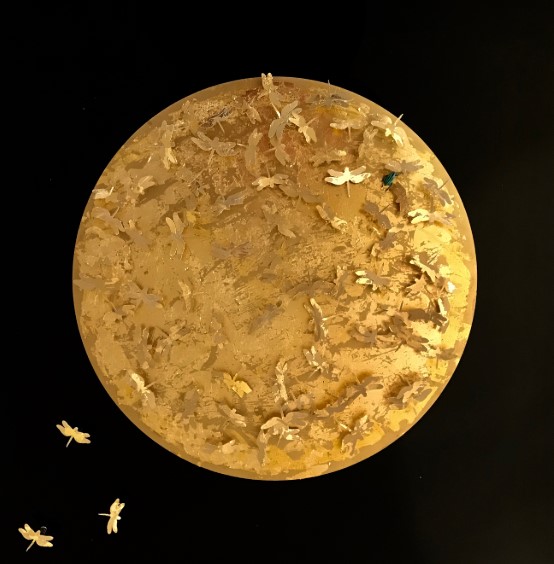
In Conversation: Inside the mind of mixed-media artist, Patricia Mitchell
Words: Polly
Photos: Patricia Mitchell Design
“I’m going to make everything around me beautiful, that will be my life” – Elsie de Woolfe
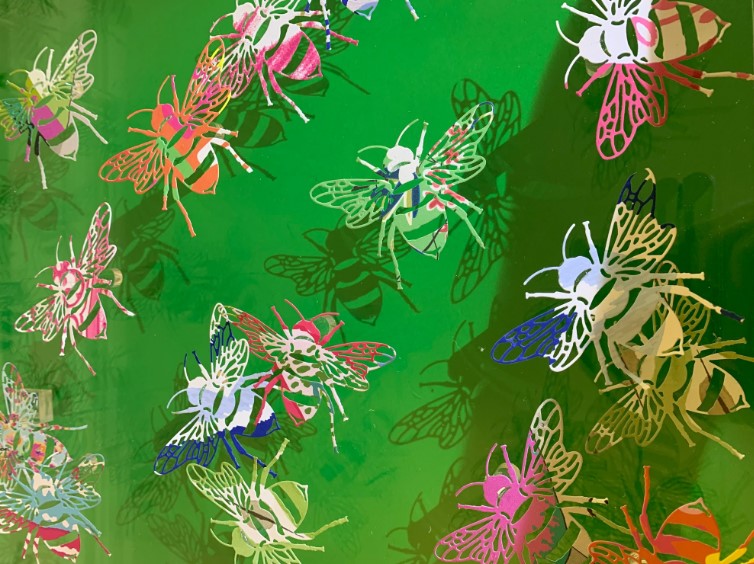
Had you always intended to be an artist?
Of any of the ‘streaks’ that a child may have, whether it be maths, English, science or art – the honour of art and creativity was awarded to my family. My mother was an extremely talented sculptor, my father, a very clever engineer. Both my sisters are brilliant cooks, however culinary skills are beyond me and I seem to mess up every meal I make. Thankfully I chose a husband who not only is a brilliant cook, he is also really interested in food!
Therefore the art section within my family is my domain, for that I am most grateful! Although I was dying to go to art school, my parents steered me toward a career, with a premise that once I had learnt the way of each facet of the corporate world I would feel ready to go to art school, as a mature student. My first job was with an art dealer in Mayfair having left school at 18, with only a few qualifications under my belt. That lasted all of 6 months.
The day before my departure I had put a small priceless Renoir drawing into a cardboard envelope with a postage stamp and popped it through the nearest letterbox on Bond Street. I had misunderstood the ‘ Send the Renoir to…..’ request. Thankfully it arrived the other end unharmed!
Taking a leap of faith takes enormous courage, especially into the precarious world of art. What prompted you to go for it?
By the time I gave up on the corporate world some 16 years later, I had made my way up the ladder from a low paid receptionist to having opened and managed 5 business centres in Mayfair. I was responsible for taking on old wrecks of buildings, designing, managing the builders and budgets, interior designing, sorting the IT and taking on staff. It was also my job to let the office space. During this time, my goal was still to get to art school, but following my parents advice was to make sure I had a Plan B in the bag before I took a leap of penniless faith. One day having had a rotten morning with an equally rotten boss, I ran away from the office and went straight to Barclays Bank on Bruton Street Mayfair and chatted to a Barclays rep who quite literally changed my life.
In tears, I told her my goal, and together we picked through my accounts, set up new accounts, she held onto my dream as much as I did.
At the end of the meeting she shook me by the hand and said, ‘now you go and find your real life, good luck’. That afternoon, without hesitation, I enrolled in a Fine Art Sculpture course at the Heatherly School of Art, I handed in my notice and within a few days had landed a part time job to keep the pennies rolling in. Today, when I walk past that Barclays, I always stop, touch the wall and give my thanks to that lady. I wonder where she is now?
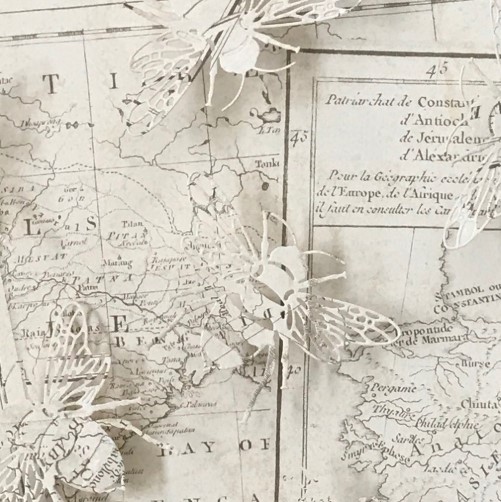
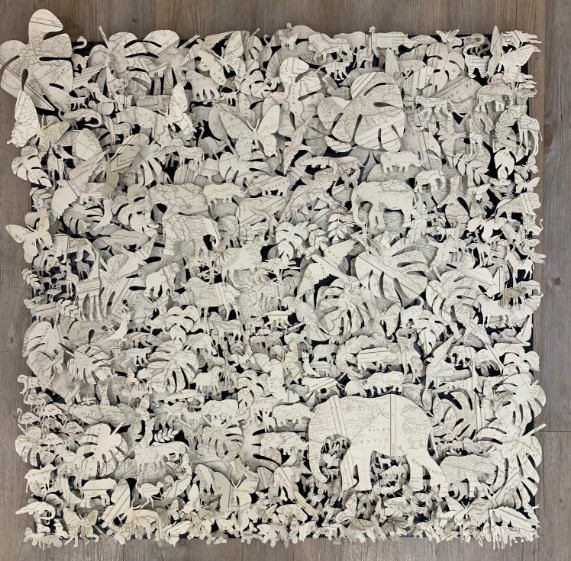
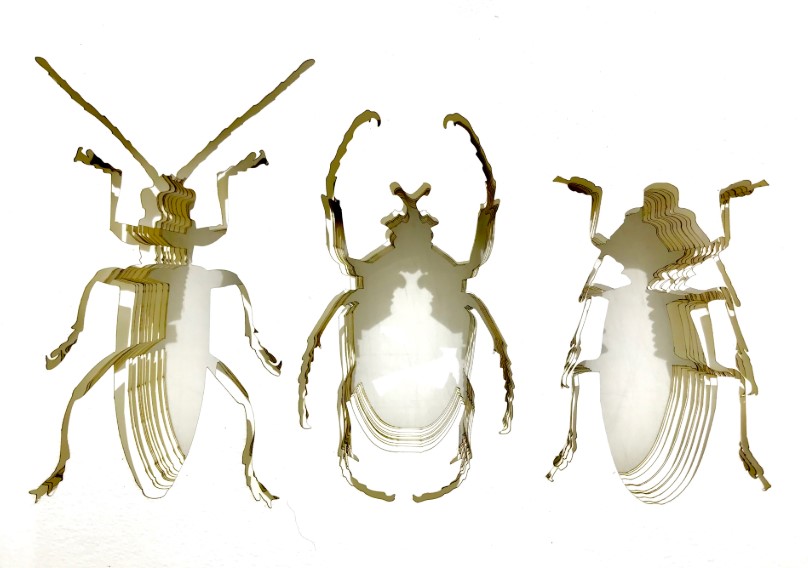
Was a corporate start in anyway beneficial to working as an artist?
I really am so relieved that my parents steered me away from art school at such a young age, and to make my way in the corporate world before following my dream. During those laborious years of driving a desk I learnt every facet of running a business and how ‘to do’ business. Art students nowadays are given a much rounder art education, which helps them on their way to choosing the right creative path for them. If that had been around in my day, then perhaps things would be different. However, I don’t regret the experience I gained from engaging professionally with senior executives, working with a budget, working as a team, and generally working very hard indeed. I am the other end of the spectrum of workshy – thanks to my corporate life.
What was the biggest adjustment from corporate to creative?
To not have a lovely pay cheque at the end of each month was awful. My social life was turned upside down, going out 1 night a week instead of 5, no holidays abroad and certainly clothes were bought as and when. It was tough, but finally being at art school, within a creative atmosphere with people who shared my passion was worth any fat salary. I would never go back to the corporate world.
Were your family supportive?
During this time my father became my mentor. Back in the early 80’s he had started an engineering company up from nothing which he ran up until the day he died, aged 80, in May this year (2019). Whenever I had a work problem, or a difficult client, he was always there to tell me what to do. He cheered me on, booted me on, and told me never to give up. He had a very strong work ethic which I have inherited.
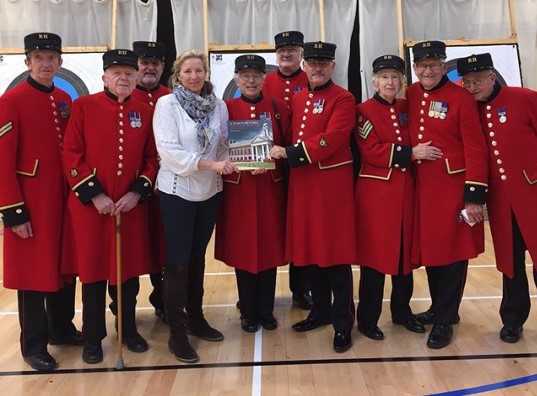
Around this time you also started working as a photographer?
To help fund my new student lifestyle I picked up an old hobby, photography. I spent my free time taking photographs of my friends children, which resulted in a knock on effect.
Yes, amazingly, you were the first female resident photographer with the Chelsea Pensioners. This must have been such a privilege?
Over 7 years I went from a zero jobbing photographer and sculpture student to getting a Residency at The Royal Hospital Chelsea, where I was to spend 2.5 years photographing the daily lives of the Chelsea In-Pensioners. My work and words were picked up by Merrell Publishers and in 2012 a book was published: A Year In Pictures: The Royal Hospital Chelsea.
Soon after, I got married and our daughter was born so we decided to move to the country. I gave up photography. No job would be better than publishing a book. I was more than ready to retire my camera.
Who, or what inspires you?
Nature inspires me. Every single little thing about it – from the earth to the sky. Mother Nature has given us the greatest gift of trees, animals, plants, sky, day, night, sleep – yet as a global nation we abuse it every day. We try of course we do – but because consumerism is so out of control no-one, even me is prepared to live without a warm roof over our heads, a computer, a mobile phone, a fridge,TV to even shampoo that comes in a plastic bottle. Human life on earth has become lazy and commercialised. So through my art I hope I can remind people of the real beauty of our world. When I go on walks with my family or friends, not only do I make sure they stop and look around, at the horizon, hedges and also up at the tree canopy to see birds flying. That moment is art within itself. It makes me smile to see their joy and say ‘look at that!’.
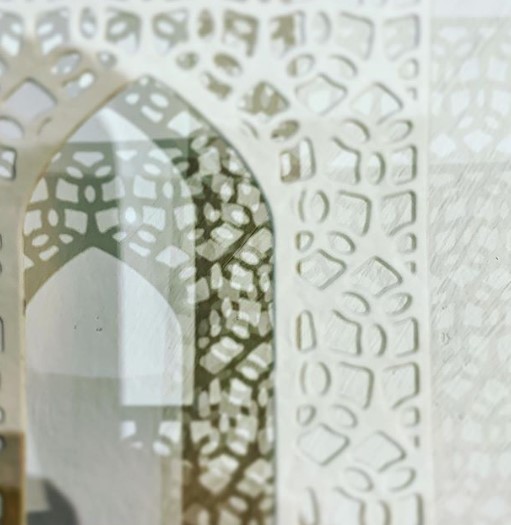
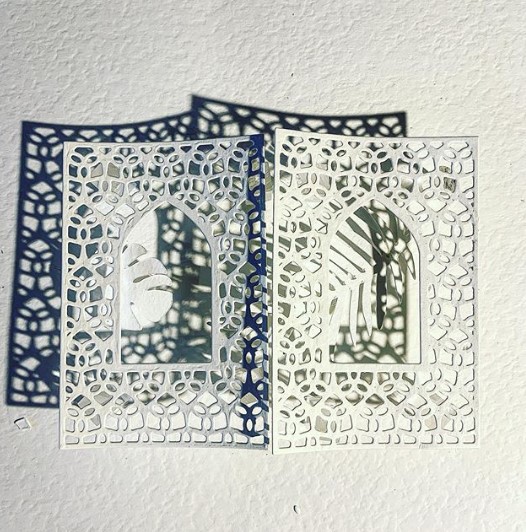
Make a story out of these words: Indian Palace, looking out through ornate carved windows to a beautiful garden, swaying palms, swooping birds, setting sun, dancing shadows, cool breeze (a cold gin and tonic), peace.
This sounds incredibly romantic and is the premise for your current work of 100 maquette windows. Is this a commission? What is the inspiration?
I have held a long term fascination with India, sadly I have only seen snapshots on documentaries, books and photographs. I traveled extensively throughout Africa and varying other countries, but somehow never got to India. My great grandparents lived in India during the Raj and often wonder what kind of life they led. My Great Grandmother sadly was widowed when Granny was very young and they immediately left India to live in Paris. However, having read The Fishing Fleet by Anne De Courcy, her beautiful words gives us a fascinating insight about the lives of British women in the early 1900’s, sent to India to find a husband; their lavish lifestyles and hectic social scene often at the Maharajas palaces. This beautiful book is definitely the basis of my new piece entitled ‘The Old Mahal’, which is sculptured using paper cut Indian windows, palm fronzes and a variety of Indian animals. My aim is to transport us back to the romance of the Raj during the turn of the century.
Your work has a fragility to it, beautifully delicate and intricate. What led you to work with paper and aluminium?
For many years, I studied figurative sculpture using wax and clay. Sculpting can take on many forms using different mediums. I love using paper as its so accessible (look after your magazines or I could rip them up!), and aluminum because it is such an interesting and different material to use.
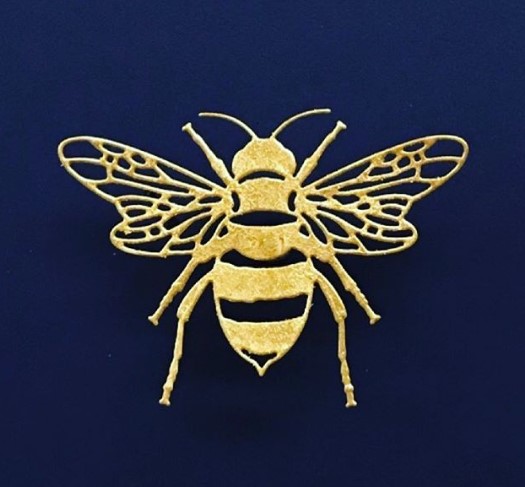
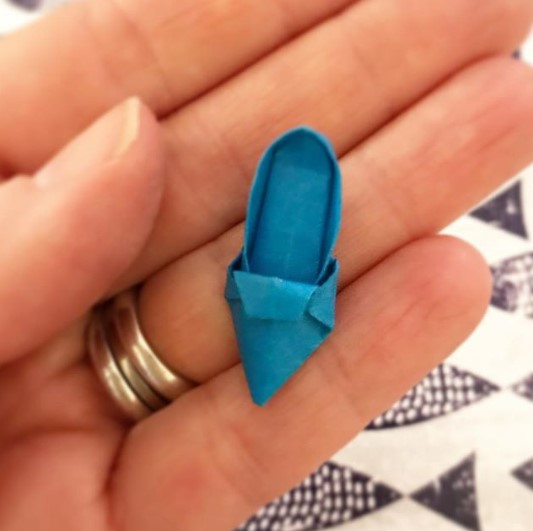
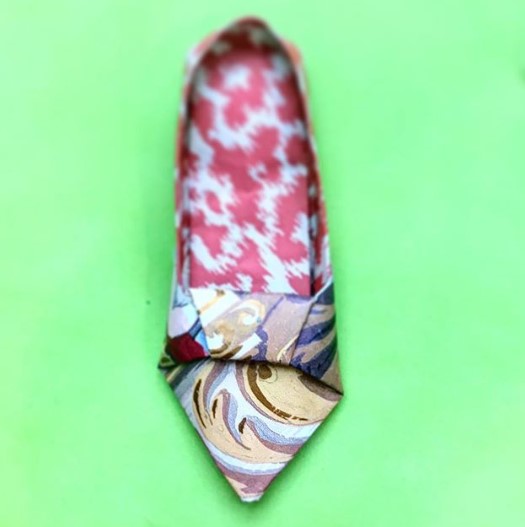
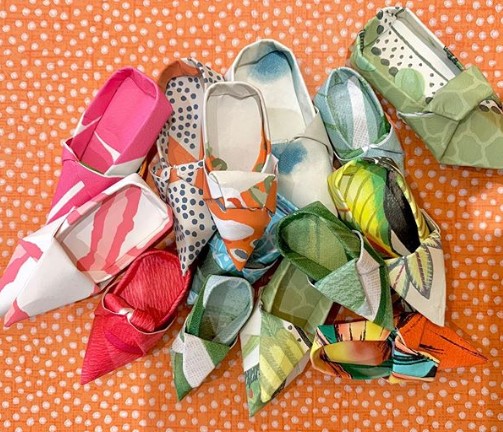
Probably my favourite piece is your origami shoes made from pieces of wallpaper. Tell us more about where this idea came from, where you learned origami and how long the 500 shoes took you to make?
Ahh, thank you so much! Some years ago I watched a documentary about origami and had an enormous urge to have a go. There are millions of tutorials on You Tube, so I picked one ‘make’, followed the folds carefully and voila – a square piece of paper became a pretty dress within 10 easy moves. This made me hungry for more and before I knew it, I had about 15 really good origami shapes learnt off by heart. The slippers being one of them. That is my favourite fold, so I thought, why not make a picture? Choosing the papers was the fun bit, then it took around 80 hours to make 500 of them and place them on the board. Preparing the board is also a laborious process. I use foamex, which needs sanding, undercoating, and a further 3 coats with sanding between each coat. This gives it a flawless and rich finish.
Origami also formed a part of your work for Help For Heroes, teaching it as a form of cognitive therapy for military personnel facing mental health challenges. This must have been a wonderful and rewarding experience?
Yes it was such an honour to start this programme at our local Help the Heroes rehabilitation centre. However, our family suffered a sudden death of a child. Within a split second our world fell apart and we all had to pull together and find ways to deal with the grieving process. My way was through origami. It was a strong tool and in turn helping groups of soldiers, serving and retired, who were suffering with depression and PTSD also helped me to gain strength. It was an incredibly rewarding experience and one I will never forget.
What life lessons have you learned from both groups of veterans?
Working with old and young veterans puts trivial ‘first world problems’ into perspective. I loved every minute of working with the In-Pensioners, for two and a half years! I had the honour of interviewing and photographing so many honourable men and women, even some who had fought in the First World War. There were times when I listened to friends rant about their dishwasher breaking down, and only a few hours before I had been interviewing a chap who had helped build the bridge over The River Kwai, a prisoner of war who was starved and whipped to near death. When I lay awake at night worrying if I had remembered to put the wheelie bin out for example, I have to pinch myself and say ‘ it really doesn’t matter does it?’
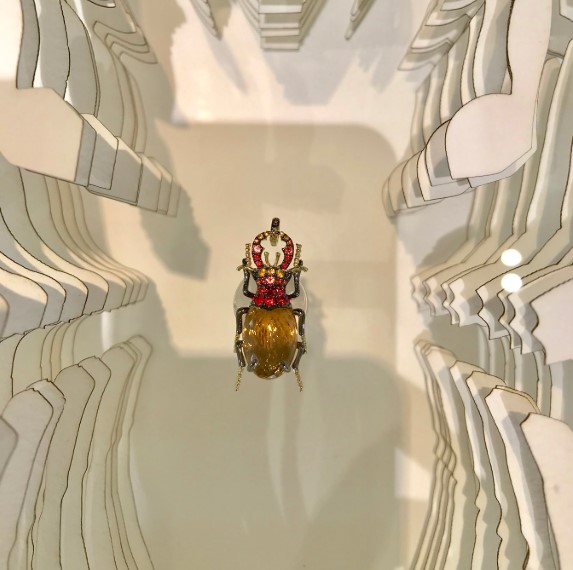
Your body of work also includes a collaboration with jewellery designer Annoushka Ducas (MBE) on her Beetle Collection, in January 2019. Tell us more about this and how you shifted from artist to visual merchandiser on this project?
Annoushka contacted me in November 2018 and awarded me the greatest of honours to design and build her shop window and boutique displays to celebrate the launch of the collection. Annoushka had been following me on instagram for a while, and liked the look of my work. After some initial consultations at her flagship store in Chelsea, we came up with a contemporary and eye catching design for the boutique windows in Chelsea, her boutique in Mayfair and Hong Kong and the large display cabinet in Claridges Hotel. It was incredibly hard work, but very rewarding, giving me first hand experience into the world of visual merchandising. A large and involved subject which I am still researching! I used the engineering drawings of the beetle charm (with a little change here and there) to use as a template for huge 200cm tall beetles, made of neon perspex which hung in the windows. I also designed framed beetles using coloured perspex, and, using entomology as my theme, produced layered beetle cutouts in my signature papers. My windows got some great coverage online and those on South Molton Street became a pop up tourist attraction! (Main image top: Anoushka shop windows)
Do you enjoy this fluidity of role, is ‘artist’ too narrow a definition?
To be honest, I don’t know really what to call me. When people ask what I do, I almost dread saying ‘artist’, as that begs the question, ‘do you paint’. I respond, ‘ No I sculpt with paper, aluminum , use Perspex etc’. Instead of gaining a reaction, the answer prompts a gaze and so I have to shift the subject matter. If only I was a landscape painter, it would make my life so much easier. Any help with this would be most welcome!
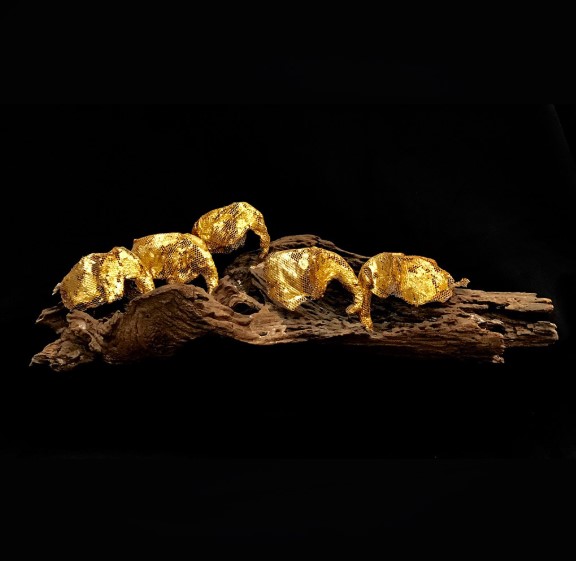
Elephants are extremely significant in your life, from collecting all things ‘elephant’ as a child to working with the Born Free Foundation in Kenya. What was your role at the foundation and what makes elephants particularly captivating?
I have always felt my spirit animal is the elephant. I collected them as a child and the whole reason why I backpacked through Africa was just so I could see the elephants in the wild. I didn’t get to touch and feel an elephant until I went to Thailand and Sri Lanka, but somehow, the African elephant is far more majestic and strong. I worked for the Born Free Foundation for two sabbaticals during my corporate life. The first time, I helped build rope ladder bridges across roads to allow Colobus monkeys to cross safely, and the second time I worked on a baboon rescue and castration programme. They were reproducing tenfold and living behind these huge hotels. The cruelty they suffered was jaw dropping, the traps were disgusting. So I was part of the vet team, untangling these poor creatures from snares and helping with rehabilitation. We also monitored and captured some poor alpha males who were just a little too pleased with their virility and castrated them! During these times, I was so lucky to go on the most incredible game drives, sometimes to mend fences or to check to see if any traps had been set by poachers. It was a magical time, which had to come to an end, as I had a mortgage to pay!
In your recent Instagram TV video you explained how you source the driftwood for your elephant works from New Zealand and personally choose each piece from the shipping container. Does the origin give the piece more significance for you?
Absolutely! Being in a warehouse full of wood which has traveled thousands of miles across many oceans, then washed up on a Jurassic coast in New Zealand has a power to it. The fact that each piece of wood could be up to a thousand years old (so I was told) is a subject within itself. Working with this wood is an honour and a privilege which I cannot put into words. No other wood would work, it symbolises the power and strength of the elephant.
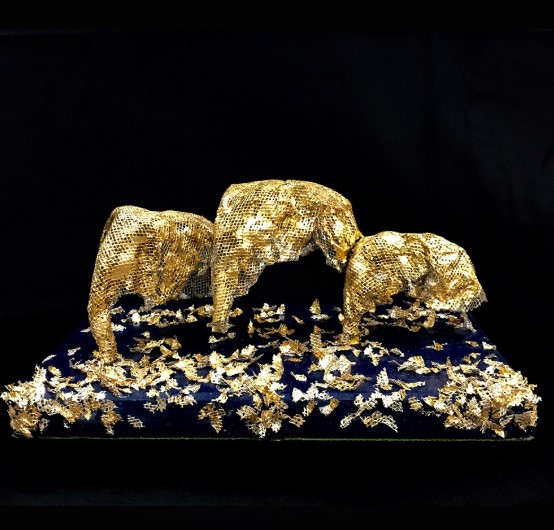
Talk us through the process of making your elephants and why you use gold leaf?
I use a thin gauge aluminum mesh which is very malleable and such fun to use. I first cut a shape and use various tools and objects to mould the trunk, head and back. The abstracted shape of the elephant is my design. I don’t give my elephant sculptures legs as I feel the body and its head are the most endearing part. The design is my signature. Having made the shape, I then coat the mesh with an oil based gold paint. I then distress the shape using a mix of gold leaf and Fools Gold. Gold Leaf alone is too glitzy, and using the fools gold gives it an antiquarian look and feel.
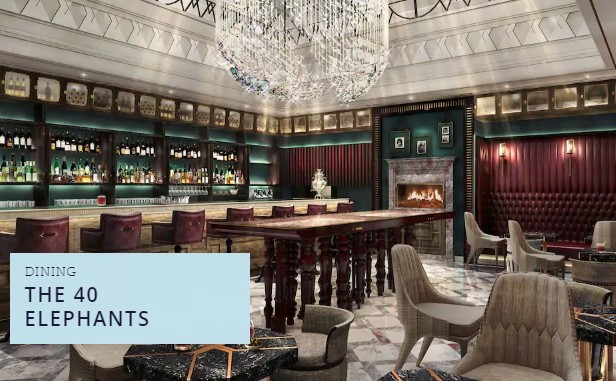
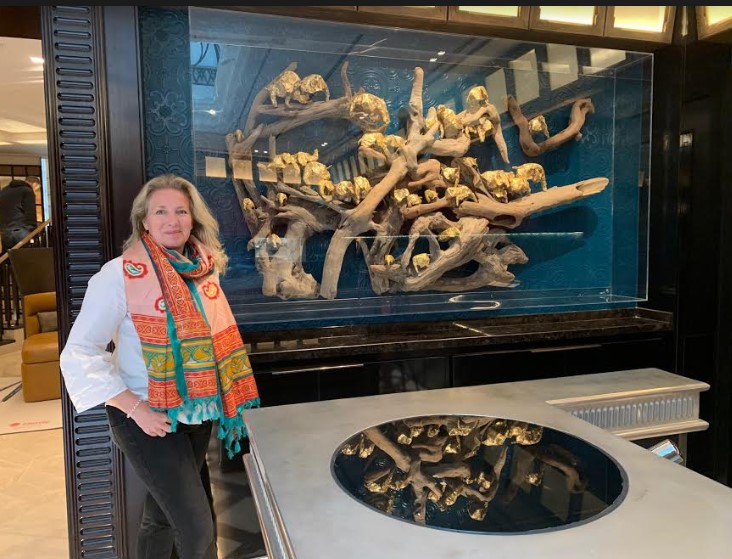
A piece now resides in the Forty Elephants restaurant at the Hyatt Hotel and former Great Scotland Yard HQ, near Covent Garden. Explain the ’40 Elephants’ and how this commission came about?
The curator of the art collection bought a piece of my work at an exhibition. She then approached me and asked if I would make a sculpture that would be fitting to the design of the bar. After initial consultation, I came up with the design which was incredibly challenging. I had to fit a 200cm sculpture into a 26cm recess. Somehow I managed it, and it is one of the proudest moments of my life seeing it there.
The Forty Elephants were a notorious gang of female thieves who ransacked London during the turn of the 20th Century. The main bar at the new Great Scotland Yard Hotel has been named after them, so my sculpture pays homage to them.
What does a typical day in the world of Patricia Mitchell Design look like?
Now my days are my own starting at 7am, running a house, a family, a dog and then my business. I get to my studio at around 10am having done the ‘routine’, and work all the way through to 3pm. To then go back to the family management and eventually if I have a lot on, I will disappear back into my studio at 9pm and work until midnight. My husband really respects what I have done, and encourages me not to give up on deadlines or my strict work ethic. I do not work at weekends and we still maintain a very happy work, life, marriage and parent balance.
Did you have careers advice at school? What did they suggest?
I didn’t do a stroke of work, I just wanted to be outside all the time or be in the art room. The staff gave up on me and suggested that I became a ‘Mothers Help’. As a compromise, I went off to secretarial college, reluctantly, and moved up to London and started working at 18. I absolutely do not regret not going to university. Unless one is training to do a job such as a doctor, vet, lawyer then yes of course university is a must.
If I ever had to employ a design team, I would interview those without a degree but with lots of life experiences, engaging, sociable, entrepreneurial. One doesn’t need a degree to have all of that.
What was your very first job?
Saturday mornings, stacking 100’s of crates on our old family farm. It was really hard work, but I got paid 50p an hour!
If you weren’t working as an artist what do you think you would have been?
I think I would have carried on with the corporate world. Perhaps I would be on a huge salary, asking my PA to organise my first class flight to my huge villa in Mustique. I’d be absolutely miserable. My very comfortable life would be without soul, depth or meaning.
What, where, or who, would be your dream commission?
I often get asked this. My absolute dream – actually not my dream – my GOAL, is to provide art for Kit Kemp, for all her Firmdale Hotels. I love her design and work ethos. I really look at her as my mentor (although she has no idea who I am). I would also like to make an enormous sculpture for a huge entrance hall in a London skyscraper.
So, what’s next for Patricia Mitchell Design?
To just keep on going as I am, for my daily work/life juggling act to keep as manageable as possible and to aim for the stars. I share a lot of goals, hopes and dreams with the universe, but that’s between me and the universe!
Sources
Patricia welcomes design collaborations, commissions and private sales, please contact her at;
patriciamitchelldesign.com
@patriciamitchelldesign
For hotel information, please visit;
Great Scotland Yard Hotel
